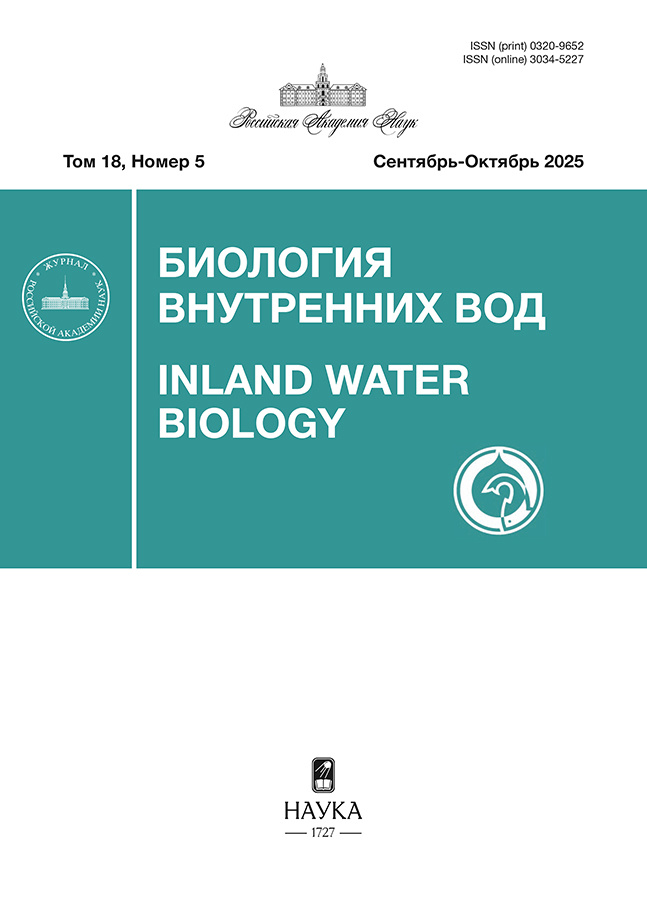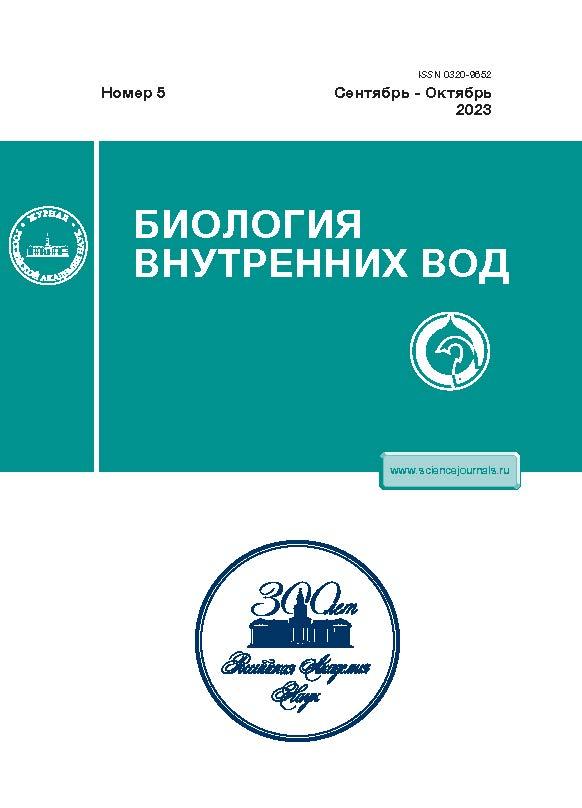Уникальные гаплотипы Artemia salina (Crustacea, Branchiopoda, Anostraca) в гиперсоленом оз. Сасык-Сиваш (Крым)
- Авторы: Лантушенко А.О.1, Мегер Я.В.1, Гаджи А.В.1, Ануфриева Е.В.1,2, Шадрин Н.В.1,2
-
Учреждения:
- Севастопольский государственный университет
- Федеральный исследовательский центр Институт биологии южных морей им. А.О. Ковалевского Российской академии наук
- Выпуск: № 5 (2023)
- Страницы: 671-679
- Раздел: Статьи
- URL: https://rjeid.com/0320-9652/article/view/669908
- DOI: https://doi.org/10.31857/S032096522305008X
- EDN: https://elibrary.ru/REAHCK
- ID: 669908
Цитировать
Полный текст
Аннотация
Исследована генетическая структура популяции вида Artemia salina (L., 1758), из гиперсоленого оз. Сасык-Сиваш на основе фрагмента гена первой субъединицы цитохром оксидазы с COI митохондриальной ДНК. Реконструкция филогении выполнена с использованием всех имеющихся в международной базе данных GenBank (NCBI) нуклеотидных последовательностей данного гена для вида salina. Установлены генеалогические связи между COI гаплотипами и выявлены филогеографические паттерны. В западно-средиземноморских популяциях отмечены общие гаплотипы, что может быть следствием их расположения в едином миграционном коридоре птиц, которые, как известно, способствуют пассивному распространению покоящихся стадий артемии. Географически изолированные группы популяций из Ливии, Туниса, Египта, Кипра и Крыма характеризуются уникальными гаплотипами, в настоящее время не обнаруженными в других средиземноморских популяциях. Высказано предположение, что уникальные гаплотипы могут быть эндемичными для географически удаленных регионов.
Ключевые слова
Об авторах
А. О. Лантушенко
Севастопольский государственный университет
Email: meger_yakov@mail.ru
Россия, Севастополь
Я. В. Мегер
Севастопольский государственный университет
Автор, ответственный за переписку.
Email: meger_yakov@mail.ru
Россия, Севастополь
А. В. Гаджи
Севастопольский государственный университет
Email: meger_yakov@mail.ru
Россия, Севастополь
Е. В. Ануфриева
Севастопольский государственный университет; Федеральный исследовательский центр Институт биологии южных морейим. А.О. Ковалевского Российской академии наук
Email: meger_yakov@mail.ru
Россия, Севастополь; Россия, Севастополь
Н. В. Шадрин
Севастопольский государственный университет; Федеральный исследовательский центр Институт биологии южных морейим. А.О. Ковалевского Российской академии наук
Email: meger_yakov@mail.ru
Россия, Севастополь; Россия, Севастополь
Список литературы
- Балушкина Е.В., Голубков С.М., Голубков М.С. и др. 2009. Влияние абиотических и биотических факторов на структурно-функциональную организацию экосистем соленых озер Крыма // Журн. общ. биол. Т. 70. № 6. С. 504.
- Adamowicz S.J., Purvis A. 2005. How many branchiopod crustacean species are there? Quantifying the components of underestimation // Global Ecol. Biogeogr. V. 14. P. 455. https://doi.org/10.1111/j.1466-822X.2005.00164.x
- Adamowicz S.J., Menu-Marque S., Hebert P.D., Purvis A. 2007. Molecular systematics and patterns of morphological evolution in the Centropagidae (Copepoda: Calanoida) of Argentina // Biol. J. Linnean Soc. V. 90. P. 279. https://doi.org/10.1111/j.1095-8312.2007.00723.x
- Anufriieva E.V., Shadrin N.V. 2015. Morphometric variability of Arctodiaptomussalinus (Copepoda) in the Mediterranean-Black Sea region // Zool. Res. V. 18. № 36(6). P. 328.
- Anufriieva E., Kolesnikova E., Revkova T. et al. 2022. Human-Induced Sharp Salinity Changes in the World’s Largest Hypersaline Lagoon Bay Sivash (Crimea) and Their Effects on the Ecosystem // Water. V. 14 (3)403. https://doi.org/10.3390/w14030403
- De Gelas K., De Meester L. 2005. Phylogeography of Daphnia magna in Europe // Mol. Ecol. V. 14. P. 753. https://doi.org/10.1111/j.1365-294X.2004.02434.x
- De Meester L., Gómez A., Okamura B., Schwenk K. 2002. The Monopolization hypothesis and the dispersal-gene flow paradox in aquatic organisms // Acta Oecologica. V. 23. P. 121. https://doi.org/10.1016/S1146-609X(02)01145-1
- De Vos S., Rombauts S., Coussement L. et al. 2021. The genome of the extremophile Artemia provides insight into strategies to cope with extreme environments // BMC Genom. V. 22 (1). P. 1. https://bmcgenomics.biomedcentral.com/articles/10.1186/s12864-021-07937-z
- Eimanifar A., Van Stappen G., Marden B., Wink M. 2014. Artemia biodiversity in Asia with the focus on the phylogeography of the introduced American species Artemia franciscana Kellogg, 1906. // Mol. Phylogen. and Evol. V. 79. P. 392. https://doi.org/10.1016/j.ympev.2014.06.027
- Frisch D., Green A.J., Figuerola J. 2007. High dispersal capacity of a broad spectrum of aquatic invertebrates via waterbirds // Aquat. Sci. V. 69(4). P. 568. https://doi.org/10.1007/s00027-007-0915-0
- Fontaneto D. 2019. Long-distance passive dispersal in microscopic aquatic animals // Mol. Ecol. V. 7. P. 10. https://doi.org/10.1186/s40462-019-0155-7
- Green A.J., Sánchez M.I., Amat F. et al. 2005. Dispersal of invasive and native brine shrimps Artemia (Anostraca) via waterbirds // Limnol., Oceanogr. V. 50. P. 737.
- Gómez A., Carvalho G.R., Lunt D.H. 2000. Phylogeography and regional endemism of a passively dispersing zooplankter: mitochondrial DNA variation in rotifer resting egg banks // Proc. Royal Soc. Series B. V. 267. P. 2189. https://doi.org/10.4319/lo.2005.50.2.0737
- Gómez A., Serra M., Carvalho G.R., Lunt D.H. 2002. Speciation in ancient cryptic species complexes: evidence from the molecular phylogeny of Brachionus plicatilis (Rotifera) // Evolution. V. 56. P. 1431. https://doi.org/10.1111/j.0014-3820.2002.tb01455.x
- Gómez A., Montero-Pau J., Lunt D.H. et al. 2007. Persistent genetic signatures of colonization in Brachionus manjavacas rotifers in the Iberian Peninsula // Mol. Ecol. V. 16. P. 3228. https://doi.org/10.1111/j.1365-294X.2007.03372.x
- Hebert P.D. 1998. Variable environments and evolutionary diversification in inland waters // Adv. Mol. Ecol. P. 267.
- Hebert P.D., Witt J.D., Adamowicz S.J. 2003. Phylogeographical patterning in Daphnia ambigua: Regional divergence and intercontinental cohesion // Limnol., Oceanogr. V. 48. P. 261. https://doi.org/10.4319/lo.2003.48.1.0261
- Hessen D.O., Jensen T.C., Walseng B. 2019. Zooplankton diversity and dispersal by birds; insights from different geographical scales // Frontiers in Ecol. and Evol. V. 20. P. 7. https://doi.org/10.3389/fevo.2019.00074
- Hall T., Biosciences I., Carlsbad C. 2011. BioEdit: an important software for molecular biology // GERF Bull Biosci. V. 2(1) P. 60.
- Ishida S., Taylor D.J. 2007. Mature habitats associated with genetic divergence despite strong dispersal ability in an arthropod // BMC Evol. Biol. V. 7. P. 52. https://doi.org/10.1186/1471-2148-7-52
- Kumar S., Stecher G., Li M. et al. 2018. MEGA X: molecular evolutionary genetics analysis across computing platforms // Mol. Biol. Evol. V. 35(6). P. 1547. https://doi.org/10.1093/molbev/msy096
- Lantushenko A., Meger Y., Gadzhi A. et al. 2022. Artemia spp. (Crustacea, Anostraca) in Crimea: New Molecular Genetic Results and New Questions without Answers // Water. V. 14(17). P. 2617. https://doi.org/10.3390/w14172617
- Le J., Cho B.C., Park J.S. 2022. Transcriptomic analysis of brine shrimp Artemia franciscana across a wide range of salinities // Mar. Genom. V. 61: 100919. https://doi.org/10.1016/j.margen.2021.100919
- Leigh J.W., Bryant D. 2015. POPART: full-feature software for haplotype network construction // Meth. Ecol. and Evol. V. 6. № 9. P. 1110. https://doi.org/10.1111/2041-210X.12410
- Marden B., Brown P., Bosteels T. 2020. Great Salt Lake Artemia: ecosystem functions and services with a global reach // Great Salt Lake Biol. P. 175. https://doi.org/10.1080/10454438.2018.1484838
- Mergeay J., Verschuren D., De Meester L. 2005. Cryptic invasion and dispersal of an American Daphnia in East Africa // Limnol., Oceanogr. V. 50. P. 1278. https://doi.org/10.4319/lo.2005.50.4.1278
- Munoz J., Gomez A., Green A.J. et al. 2008. Phylogeography and local endemism of the native Mediterranean brine shrimp Artemia salina (Branchiopoda: Anostraca) // Mol. Ecol. V. 17(13). P. 3160. https://doi.org/10.1111/j.1365-294X.2008.03818.x
- Muñoz J., Amat F., Green A.J. et al. 2013. Bird migratory flyways influence the phylogeography of the invasive brine shrimp Artemia franciscana in its native American range // Peer J. V. 1. P. 200. https://doi.org/10.7717/peerj.200
- Naceur H.B., Romdhan M.S., Stappen G.V. 2020. Potential Use of fatty acid profile for Artemia spp. discrimination // Inland Water Biol. V. 13. № 3. P. 434. https://doi.org/10.1134/S199508292003013X
- Paland S., Colbourne J.K., Lynch M. 2005. Evolutionary history of contagious asexuality in Daphnia pulex // Evolution. V. 59. P. 800. https://doi.org/10.1111/j.0014-3820.2005.tb01754.x
- Penton E.H., Hebert P.D., Crease T.J. 2004. Mitochondrial DNA variation in North American populations of Daphnia obtusa: continentalism or cryptic endemism? // Mol. Ecol. V. 13. P. 97. https://doi.org/10.1046/j.1365-294X.2003.02024.x
- Ronquist F., Teslenko M., Van Der Mark P. et al. 2012. MrBayes 3.2: Efficient Bayesian phylogenetic inference and model choice across a large model space // Syst. Biol. V. 61. P. 539. https://doi.org/10.1093/sysbio/sys029
- Rozas J. 2017. DnaSP 6: DNA sequence polymorphism ana-lysis of large data sets // Mol. Biol. Evol. V. 34. P. 3299. https://doi.org/10.1093/molbev/msx248
- Sainz-Escudero L., López-Estrada E.K., Rodríguez-Flores P.C., García-París M. 2021. Settling taxonomic and nomenclatural problems in brine shrimps, Artemia (Crustacea: Branchiopoda: Anostraca), by integrating mitogenomics, marker discordances and nomenclature rules // Peer J. V. 9. P. 10865. https://doi.org/10.7717/peerj.10865
- Sainz-Escudero L., López-Estrada E.K., Rodríguez-Flores P.C., García-París M. 2022. Brine shrimps adrift: Historical species turnover in Western Mediterranean Artemia (Anostraca) // Biol. Invasions. V. 24. P. 2477. https://doi.org/10.1007/s10530-022-02779-6
- Sanchez M.I., Paredes I., Lebouvier M., Green A.J. 2016. Functional role of native and invasive filter-feeders, and the effect of parasites: learning from hypersaline ecosystems // PLoS One. V. 11(8). e0161478. https://doi.org/10.1371/journal.pone.0161478
- Shadrin N., Stetsiuk A., Anufriieva E. 2022. Differences in mercury concentrations in water and hydrobionts of the crimean saline lakes: does only salinity matter? // Water. V. 14(17): e2613. https://doi.org/10.3390/w14172613
- Templeton A., Crandall K., Sing C. 1992. A cladistic analysis of phenotypic associations with haplotypes inferredfrom restriction endonuclease mapping and DNA sequencedata. III. Cladogram estimation // Genetics. № 132. P. 619. https://doi.org/10.1093/genetics/132.2.619
- Van Stappen G., Sui L., Hoa V.N. et al. 2020. Review on integrated production of the brine shrimp Artemia in solar salt ponds // Rev. Aquac. V. 12. P. 1054. https://doi.org/10.1111/raq.12371
- Weider L.J., Hobaek A., Hebert P.D., Crease T.J. 1999. Holarctic phylogeography of an asexual species complex-II. Allozymic variation and clonal structure in Arctic Daphnia // Mol. Ecol. V. 8. P. 1. https://doi.org/10.1046/j.1365-294X.1999.00522.x
- Zierold T., Hanfling B., Gómez A. 2007. Recent evolution of alternative reproductive modes in the “living fossil” Triops cancriformis // BMC Evol. Biol. V. 7. P. 161. https://doi.org/10.1186/1471-2148-7-161
Дополнительные файлы













